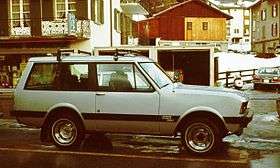Monteverdi Safari
The Monteverdi Safari is a Swiss luxury SUV first presented by Peter Monteverdi in 1976. It entered into production in 1977.[1] Production came to an end in 1982, after production of the International Harvester Scout (upon which the Safari was based, and with which the Safari shared many parts) came to an end. There was also a lower-priced version called the Sahara, which retained the Scout's original bodywork with some modifications.
| Monteverdi Safari | |
|---|---|
 | |
| Overview | |
| Manufacturer | Monteverdi |
| Production | 1976 - 1982 |
| Assembly | Binningen, Switzerland [1] |
| Body and chassis | |
| Class | SUV |
| Body style | 3-door hatchback |
| Layout | Front-engine design, Four-wheel drive[1] |
| Related | International Harvester Scout |
| Powertrain | |
| Engine | 5,210 cc 318 LA V-8 (Chrysler)[1] 5,654 cc SV-345 V8 (IH) 7,206 cc 440 RB V8 (Chrysler) |
| Dimensions | |
| Wheelbase | 2,540 mm (100.0 in)[1] |
| Length | 4,510 mm (177.6 in)[1] |
| Width | 1,800 mm (70.9 in)[1] |
| Height | 1,760 mm (69.3 in)[1] |
| Curb weight | 2,120 kg (4,670 lb) (approx)[1] 54%:46% |
History
Despite the manufacturer’s tradition as a supercar manufacturer, the 1977 domestic market price of CHF 39,000 was only CHF 5,000 higher than that of the less well-appointed Range Rover. There were relatively few luxury SUVs offered in Europe at this time, and while the Safari’s sales volumes were dwarfed by those of the Range Rover, they were high compared to the company’s other models targeted at the higher end of the Maserati/Ferrari class.[1] The body was built by Fissore, with whom Monteverdi had a long standing relationship.
The driving experience was enhanced by an automatic transmission, switchable all-wheel drive, electric windows and a well chosen selection of instruments behind the steering wheel. Despite the upright look of the body, the angle of the driver seat was relatively sporty, even though the overall height of the vehicle meant that the Safari driver was still well positioned to look down on conventional sedans/saloons.[1]
Standard equipment was originally a Chrysler 5.2 litre V-8 engine delivering a claimed 152 bhp (113 kW) at 4,000 rpm and 346 N⋅m (255 lb⋅ft) of torque. A 5.7 litre 165 bhp (123 kW) International Harvester V8 engine was also offered, and the manufacturers maintained that the drive train components were also engineered to be able to accommodate Chrysler’s 7.2 litre 305 bhp (227 kW) unit.[2] In its 5.2 litre form, the vehicle achieved a maximum speed of 165.1 km/h (103 mph) and took 13.1 seconds to reach 100 km/h (62 mph) from a standing start. The price of this level of performance in such a heavy vehicle showed up in the overall fuel consumption figure of 25.1 L/100 km (11.3 mpg‑imp; 9.4 mpg‑US) achieved during the 1977 road test from which these performance figures are taken.[1] The 7.2 litre version has a claimed top speed of 200 km/h (124 mph), and the stated consumption figures were more than 50% higher than for the 5.7 litre version.[2]
See also
References
- Leyrer, Götz (1977-05-11). Simoneit, Ferdinand (ed.). "Test: Monteverdi Safari". Auto Motor u. Sport (in German). 10 (1977): 50–56.
- Lösch, Annamaria, ed. (1981). World Cars 1981. Pelham, NY: The Automobile Club of Italy/Herald Books. p. 234. ISBN 0-910714-13-4.